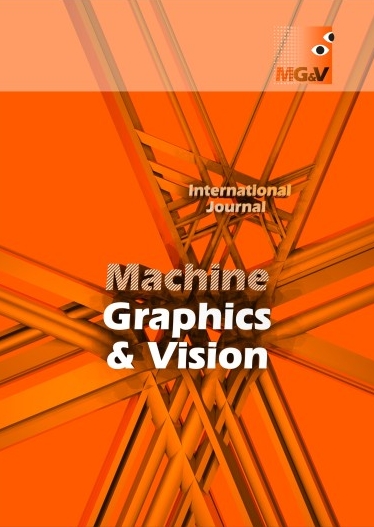Main Article Content
Generative design is used to efficiently generate design solutions with powerful computational methods. Generative design based on shape grammar is currently the most commonly used approach, but it is difficult for shape grammar to formally analyze the generated pattern. Graph grammar derived from one-dimensional character grammar is mainly used for generating and analyzing abstract models of visual languages. However, there is a significant gap between the generated node-edge graphs and the representation of shape appearance. To address these problems, we propose an improved generative design approach based on virtual-node based continuous Coordinate Graph Grammar (vcCGG). This approach defines a new type of grammatical rule named node transformation rules to convert nodes into shapes with node transformation applications. By combining node transformation applications and L-applications in vcCGG, we can generate a node-edge graph as the structure of the pattern through L-applications, and then draw the shape outline, next adjust the positions of these shapes, thus relating abstract structures and the physical layouts of visual languages. At the end of the paper, we provide an example application of this approach: generating an illustration from Emma Talbot using a combination of node transformation applications and L-applications.
Article Details
M. Agarwal and J. Cagan. A blend of different tastes: The language of coffeemakers. Environment and Planning B: Planning and Design, 25:205-226, 1998. https://doi.org/10.1068/b250205. (Crossref)
H. Bunke. Graph grammars as a generative tool in image understanding. In: Graph-Grammars and Their Application to Computer Science, pp. 8-19, 1983. https://doi.org/10.1007/BFb0000096. (Crossref)
H. H. Chau. Preserving Brand Identity in Engineering Design Using a Grammatical Approach. Ph.D. thesis, The University of Leeds, School of Mechanical Engineering, and Keyworth Institute of Manufacturing and Information Systems, 2002. https://www.researchgate.net/publication/286452884_Preserving_brand_identity_in_engineering_design_using_a_grammatical_approach.
X. Chen, A. McKay, A. de Pennington, and H. H. Chau. Package shape design principles to support brand identity. Proc. 14th IAPRI World Conference on Packaging, pp. 1-14, 2004. https://www.researchgate.net/publication/267797410_PACKAGE_SHAPE_DESIGN_PRINCIPLES_TO_SUPPORT_BRAND_IDENTITY.
G. Díaz, R. F. Herrera, F. Muñoz-La Rivera, and E. Atencio. Generative design for dimensioning of retaining walls. Mathematics, 9(16):1918, 2021. https://doi.org/10.3390/math9161918. (Crossref)
M. Flasiński. Use of graph grammars for the description of mechanical parts. Computer-Aided Design, 27:403-433, 1995. https://doi.org/10.1016/0010-4485(94)00015-6. (Crossref)
S. Garcia and L. Romao. A design tool for generic multipurpose chair design. In: Proc. Computer-Aided Architectural Design Futures, pp. 600-619, 2015. https://doi.org/10.1007/978-3-662-47386-3_33. (Crossref)
H. Göttler, J. Günther, and G. Nieskens. Use graph grammars to design CAD-systems! In: Graph-Grammars and Their Application to Computer Science, pp. 396-410, 1990. https://doi.org/10.1007/BFb0017402. (Crossref)
M. Lee, Y. Park, H. Jo, K. Kim, S. Lee, et al. Deep generative tread pattern design framework for efficient conceptual design. Journal of Mechanical Design, 144(7):011703, 2022. https://doi.org/10.1115/1.4053469. (Crossref)
Y. Liu and Y. Fan. VCGG: Virtual-node based spatial graph grammar formalism. Journal of Software, 32:3669-3683, 2021. https://doi.org/10.13328/j.cnki.jos.006164.
Y. Liu, X.-Q. Zeng, and Y. Zhu. Application of graph grammar EGG to design of ER diagrams. Computer Engineering and Design, 2014(3):1071-1075, 2014. https://api.semanticscholar.org/CorpusID:63040768.
Y. Liu, Y. Zhou, F. Yang, and H. Sun. An enhanced grammatical approach for graph drawing. In: Conf. International Conference on Artificial Intelligence, Virtual Reality, and Visualization AIVRV 2022, p. 1258803, 2023. https://doi.org/10.1117/12.2667201. (Crossref)
M. Pugliese and J. Cagan. Capturing a rebel: modeling the Harley-Davidson brand through a motorcycle shape grammar. Research in Engineering Design, 13:139-156, 2002. https://doi.org/10.1007/s00163-002-0013-1. (Crossref)
C. Qian, R. Tan, and W. Ye. An adaptive artificial neural network-based generative design method for layout designs. International Journal of Heat and Mass Transfer, 184:122313, 2022. https://doi.org/10.1016/j.ijheatmasstransfer.2021.122313. (Crossref)
A. Roudaki, J. Kong, and K. Zhang. Specification and discovery of web patterns: a graph grammar approach. Information Sciences, 328:528-545, 2016. https://doi.org/10.1016/j.ins.2015.08.052. (Crossref)
G. Song and K. Zhang. Visual xml schemas based on reserved graph grammars. In: Conf. International Conference on Information Technology: Coding and Computing. ITCC 2004, pp. 687-691, 2004. https://doi.org/10.1109/ITCC.2004.1286546. (Crossref)
G. Stiny. Introduction to shape and shape grammars. Environment and Planning B: Planning and Design, 7(3):343-351, 1980. https://doi.org/10.1068/b070343. (Crossref)
G. Stiny and J. Gips. Shape grammars and the generative specification of painting and sculpture. In: Proc. Conf. International Federation for Information Processing IFIP 1971, pp. 125-135, 1971. https://api.semanticscholar.org/CorpusID:36431081.
X. Wang, Y. Liu, and K. Zhang. A graph grammar approach to the design and validation of floor plans. The Computer Journal, 63:137-150, 2019. https://doi.org/10.1093/comjnl/bxz002. (Crossref)
S. Wannarumon, P. Pradujphongphet, and I. Bohez. An approach of generative design system: Jewelry design application. IEEE International Conference on Industrial Engineering and Engineering Management, pp. 1329-1333, 2014. https://doi.org/10.1109/IEEM.2013.6962626. (Crossref)
Y. Yu, T.-C. Hong, A. Economou, and G. Paulino. Rethinking origami: A generative specification of origami patterns with shape grammars. Computer-Aided Design, 137:103029, 2021. https://doi.org/10.1016/j.cad.2021.103029. (Crossref)
K.-B. Zhang, M. A. Orgun, and K. Zhang. A prediction-based visual approach for cluster exploration and cluster validation by HOV3. In: Proc. Knowledge Discovery in Databases. PKDD 2007, pp. 336-349, 2007. https://doi.org/10.1007/978-3-540-74976-9_32. (Crossref)
G. Ślusarczyk. A graph grammar approach to the design and validation of floor plans. Computer-Aided Design, 95:24-39, 2017. https://doi.org/10.1016/j.cad.2017.09.004. (Crossref)
G. Ślusarczyk, B. Strug, A. Paszyńska, E. Grabska, and W. Palacz. Semantic-driven graph transformations in floor plan design. Computer-Aided Design, 158:103480, 2023. https://doi.org/10.1016/j.cad.2023.103480. (Crossref)





